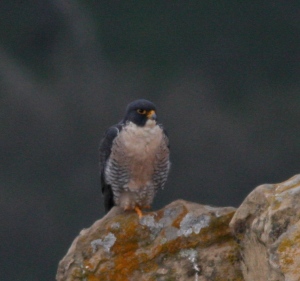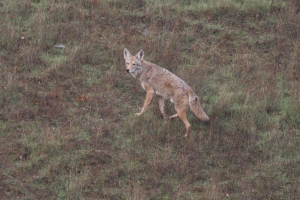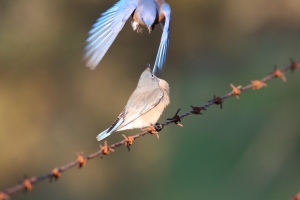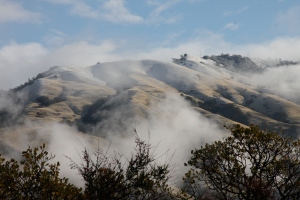Kanit, Cheryl, Joy and I went to the canyon at Sensitive Site #1 on Sunday, 11/30/08.
We got a ride into the canyon with the ranger on an open-backed 4 wheel drive vehicle. Joy and I in the front could hear Kanit and Cheryl in the outside squealing periodically as we got very close to the trail’s edge. The ranger drove us to our meadow and we piled out, Kanit and Cheryl saying it had been like a fun amusement park ride.
The ranger had not seen the peregrines so she stayed with us while we set up our scopes.
Almost immediately, both birds took off flying, then one settled into a hole in the rock. We got a scope on her. It was apparent that this was not the usual male and not the usual female. This one had a full dark hood, yellow talons, pale cere. The male of the usual pair is 12.5 and has dark orange talons and an orange cere. The female of the pair has malar stripes. After a brief discussion about the possibility of losing color in a few months (we decided that wasn’t possible) we noticed bands on the legs of this bird. The VID band is on the left while the male’s VID band is on the right. The usual female of the pair is not banded. From the distance of the canyon floor to the cliff face, it’s not possible to read a band. We didn’t get a clear look at the other bird to confirm band or talon color or any markings.
At 11:30 we decided to head for the ridge top. A 30 minute walk out of the canyon, a 20 minute drive, a 45 minute hike to the ridge and we set up our scopes.
An hour later, both birds were in the air flying, the female going after a turkey vulture, hitting it several times. She returned and settled on the top of the nest rock and all 4 scopes turned on her. She showed us only the bottom letter of the band (Z). Three of the 4 of us that saw the band agreed on the letter (I didn’t get the band in my scope, being behind bushes that obscured the view and not wanting to move too much, especially knowing there were clear views from the other scopes).
She flew and we left shortly after that with a job to do.
I went back on 12/2 and immediately saw the male. This time I was able to get a clear look at him—orange talons, orange cere, pale grey back. A short flight and a landing on another outcrop and I was able to read his band and confirm him the same male as previously at the nest site. He flew again and landed on top of the nest rock. In all, he stayed in sight for more than 2 hours.

He took off from the nest rock and dove into the canyon, then started a trans-canyon ledge display. Flying the 1/4 mile of the canyon, LOUDLY e-chupping (a constant one-word e-chup e-chup e-chupe-chup e-chup e-chup e-chup e-chup the length of the canyon—a territorial e-chup. I heard his e-chup change to a cakcakcak and heard another bird scream as he hit it or came close—he was out of my sight at that time. He flew off and I left.
On 12/7, Cheryl and I went back to the canyon ridge, spotting a coyote on the road behind the car. He headed up the hill off trail while we followed on trail. He was much faster than we were.
 It was wonderfully foggy, clearing intermittently. Except for one brief sighting of a peregrine and one brief sighting of a golden eagle, we saw nothing. We moved down into the canyon and again saw no peregrines. We left cold, tired and disappointed.
It was wonderfully foggy, clearing intermittently. Except for one brief sighting of a peregrine and one brief sighting of a golden eagle, we saw nothing. We moved down into the canyon and again saw no peregrines. We left cold, tired and disappointed.
On 12/9, I headed out again. When I was getting my gear out of the car I heard and then saw an acorn woodpecker pecking away but got distracted by a pair of western bluebirds pecking at the window of my car. The female was sitting 2 feet away from me on a barbed wire fence and the male was trying to chase off its reflection in the window of my car. Some play, some copulation, some coughing up of a pellet (the birds), and then I headed up the trail.

The tiercel was on one of his favorite rock outcroppings. He stayed for about 10 minutes, then left. I could hear him on the rock race e-chupping occasionally. At 10:30, from across the canyon I could hear wailing. With very little chance of spotting anything at 1/3 mile, I turned my scope in the direction of the wailing and spotted a peregrine shape in a tree on the opposite ridge. Lucky find. I didn’t notice until a few minutes later that there was a second peregrine in the same tree, just a little to the left of the first one I spotted. They sat there for 2 1/2 hours while I watched. At 1pm they both flew, chasing a pair of redtails and a pair of turkey vultures. They flew to my side of the canyon but the sun was in my face and I didn’t get a clear enough view to see if there were bands on the bird and certainly had no chance to read it. Neither one settled down to stay. I left around 2 pm, spotting a sharpshinned hawk flying over the trail, landing on a branch in front of me, then leaving again. And again a coyote, this time on the trail behind me.
The bluebirds were gone when I got back to the car having left some whitewash behind.
Four trips to the canyon ridge in 1 1/2 weeks. It’s getting too close to the solstice and the start of pair bonding so I won’t be heading back up there. Maybe a reading with a telescope will be possible.
I did head up again, this time on 12/16. It was raining steadily and muddy all the way up. The usual 40-45 minute hike up took 50 minutes. On the ridge trail about 20 feet in front of me, I spotted a coyote before it heard me. When it noticed, it took off up the trail at a run. I didn’t see it again but I’m sure it moved off the trail a bit ahead of me and watched as I passed it.
When I got to the nest area, nothing was in sight. It was still raining but the climb had warmed me well. I took off my gloves and set up the scope to be ready. I should have brought an umbrella to keep the rain off. I heard two different sets of e-chups and watched as a peregrine took off from the rock face, circle around once and fly back into the nest cave.
After an hour, the clouds cleared, the sun came out. With rain still around, there was a rainbow northwest of the cave.
A out came a peregrine, again flying around. This time it landed on Sentinel Rock. Immediately, it was clear this was not the 12 year old male (this one did not have the orange talons of the old male). I had the scope on it and saw a peregrine with a bright yellow cere, yellow talons and thick malar stripes. Not the banded bird we had seen last week? It stretched out the left leg to scratch its head and I couldn’t see a band.
It was e-chupping nearly constantly with a high pitched e-chup, looking around. After about 10 minutes it turned around, pooped, showed me two bare legs as it flew away.
So we have a 4th peregrine in the territory. I’m not sure if this is common in a territory in the non-breeding season when there is a full complement of adult birds.

More questions to answer. I’m a little afraid to go back and find another new bird. I did hear two peregrines today but saw only the one. It was small enough that it could have been a male and with the higher pitched voice, it’s possible.